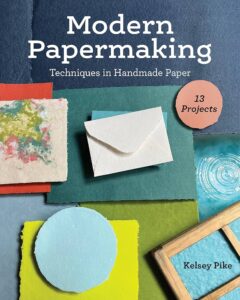SDA Book Club: Modern Papermaking reviewed by Zia Gipson
August 2, 2024
Modern Papermaking, Techniques in Handmade Paper by Kelsey Pike.

Artist and papermaker Kelsey Pike has made a significant contribution to the papermaking community and future papermakers with her book, Modern Papermaking. I know I’ll come back to this book time and again given its detailed information about the many aspects of fine papermaking—from paper’s history to the tools and processes necessary to produce competent, even beautiful sheets. If I were on a desert island and wanted to make paper, this is the kind of book I’d want to be left with.
Illustrations by Aliza Shalit and photography by the author, Patricia Bordallo Dibidox and others add an essential and attractive informational component. Pike repeats information about papermaking multiple times and in different ways, which is especially helpful for a beginner. For example, Pike gives facts about papermaking science and a clear “how to” in the section called “Basic Papermaking Steps.” Later we get an in-depth description in photographs and a step-by step process in the section “Make Basic Sheets.”
The author is a practical papermaker who makes the ancient craft accessible by including useful, detailed directions for assembling the tools and equipment needed for a papermaker’s studio. From Pike’s images and directions readers could relatively easily make a mould and deckle, paper press, dry box and other equipment using materials and supplies from the local hardware store or thrift shop. For readers wishing to deepen their understanding of papermaking craft there are directions for adding internal and external sizing to paper vats as well as using calcium carbonate and formation aid in the slurry mixture, topics I haven’t found as well explained elsewhere.
If there is something missing, it might be a better discussion of paper plants and their uses in various types of paper. Pike mentions abaca, a familiar and popular fiber in handmade paper in North America, but doesn’t refer to the high shrinkage factor which is what draws many of us to the fiber in the first place.
In future editions of this book I’d like to see paper plants referred to by their botanical names as least in the initial reference. Papermakers know the mulberry shrub (one type is Broussonetia papyrifera) as an ideal paper fiber with a much-storied use in Asia going back millennia. And they know it’s not the same plant as the big deciduous fruit-bearing trees I remember from my years in Missouri, but newcomers to papermaking might not. The author uses Japanese names for the three most common paper plants but fails to connect the Japanese word kozo to its English name mulberry, a useful synonym when looking for more information especially online. The book’s index isn’t as useful as it could be since it’s little more than the table for contents in alphabetical form. I love a robust index and this book doesn’t have one.
But I find this book an essential addition to my library. I would need it just for the color recipes the author includes saving me and others many false steps in achieving just the right color for a client or project. Finally, I am grateful to see the two sections about “Ergonomics” and “Working Comfort and Exercise.” Kelsey Pike has given us a treatise not just on how to make paper, but how to make paper sustainably and in good health for the long term.
–Zia Gipson
- Publisher: C&T Publishing (buy it here)
- Date: September 2023
- ISBN: 9781644033074
If you’ve read this book, leave a comment and let us know what you think!
Do you have a recommendation for a recent fiber-related book you think should be included in SDA’s Book Club? Email SDA’s Managing Editor, Lauren Sinner, to let her know!
